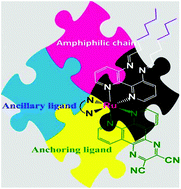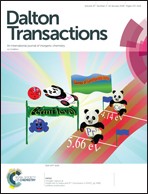Ultrafast interfacial charge transfer from the LUMO+1 in ruthenium(ii) polypyridyl quinoxaline-sensitized solar cells†
Abstract
This paper describes the implementation of robust and modular sensitizers containing aromatic–amphiphilic ligands to provide new insights into the relationship between the molecular structure and electron injection process governing the efficiency of dye-sensitized solar cells (DSSCs). The significance of this work lies in the combination of favorable experimental and theoretical results in a new class of Ru(II) polypyridyl complexes with the molecular formula of [Ru(E101)(Dicnq)x(Y)] which is named M101–M104 when X = 1 and Y = bpy, X = 1 and Y = phen, X = 2, and X = 1 and Y = 2 NCS, respectively. E101 and Dicnq ligands are 1,10-phenanthroline-5,6 heptan ammin and 6,7-dicyanodipyrido[2,2-d:2′,3′-f]quinoxaline, respectively. The good agreement between the experimental and the time-dependent density functional theory (TDDFT)-calculated absorption spectra of the M101–104 sensitizers allowed us to provide a detailed assignment of the main spectral features of the investigated dyes. M102 which contained phen as an ancillary ligand had the best photovoltaic performance which can be attributed to the higher light harvesting of M102 in the visible light region. A DSSC based on complex M102 without the E101 ligand did not show any observable power conversion efficiency (PCE), indicating the importance of the amphiphilic ligand, E101. Transient absorption studies indicated that the ratio of kreg/krec (krec = the rate constant of the recombination of the dye and kreg = the rate constant of regeneration in the presence of the electrolyte) for M101–104 is 1.1, 2.9, 1.3, and 1.2, clearly confirming a weak competition between dye regeneration and recombination. Therefore, because this ratio for M101, 103, and 104 is small, kreg ≈ krec, the operation of the device has been limited by back electron transports, subsequently enhancing the recombination process. However, the rate of recombination is relatively normal for an efficient DSSC, while the rate of regeneration is very low. Subsequently, the PCE will be poor, confirming the role of aliphatic chains in reducing the recombination process. To obtain a deeper insight into the charge transfer process in the investigated devices, ab initio DFT molecular dynamics simulations and quantum dynamics of electronic relaxation were carried out, clearly showing that the interfacial electron transfer (IET) time scale particularly depends on the type of ancillary ligand. The IET results substantially proved that M102 has the fast lifetime of 2.3 ps and 90 fs for the LUMO and LUMO+1, respectively, indicating the experimentally higher PCE of M102 compared to the other three investigated sensitizers.



 Please wait while we load your content...
Please wait while we load your content...